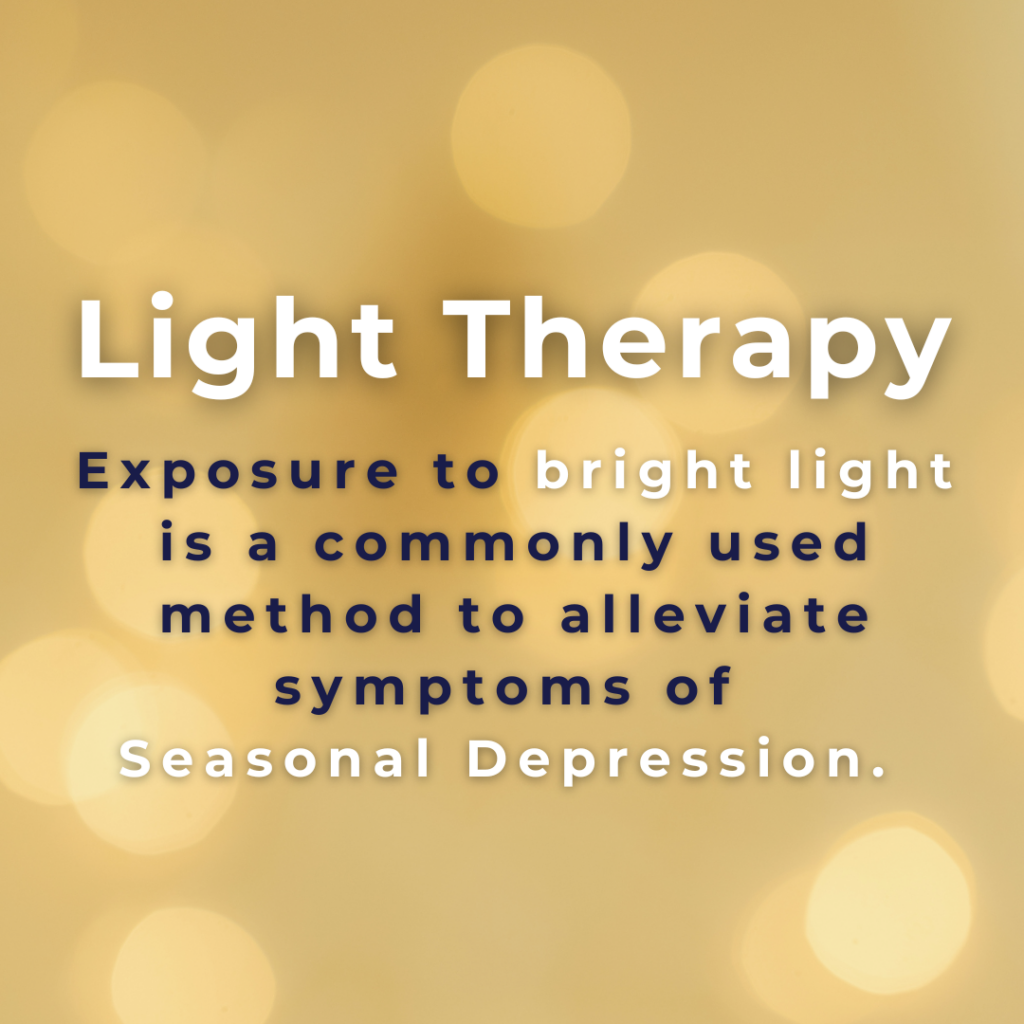Understanding and Conquering Seasonal Depression
As the days get shorter and the temperatures drop, many people experience a shift in their mood and energy levels. For some, this is more than just the “winter blues”—it’s a condition known as Seasonal Affective Disorder (SAD). This type of depression typically begins in the fall and peaks during the winter months when daylight… Read more
Reviewed by The PsychPlus Team
Staff Provider at PsychPlus
December 2, 2024

As the days get shorter and the temperatures drop, many people experience a shift in their mood and energy levels. For some, this is more than just the “winter blues”—it’s a condition known as Seasonal Affective Disorder (SAD). This type of depression typically begins in the fall and peaks during the winter months when daylight hours are limited. It can lead to feelings of hopelessness, low energy, and a general lack of motivation, making everyday life feel more challenging.
What’s concerning is that SAD affects millions of people every year, yet it often goes unrecognized or untreated. In fact, it’s believed that around 5% of the U.S. population is impacted by SAD, with symptoms lasting for weeks or even months. It’s crucial to recognize the signs early, as untreated SAD can interfere with work, relationships, and overall well-being.
In this blog, we’ll dive into the causes, symptoms, and treatment options for Seasonal Affective Disorder. Whether you’re dealing with it yourself or know someone who is, understanding SAD can help you take the right steps toward better mental health.
If you’re new to depression or want to understand more about its symptoms, you can also explore our Depression 101 blog for a deeper look into the broader spectrum of depressive disorders.
What Is Seasonal Affective Disorder?
Seasonal Affective Disorder (SAD) is a type of depression that follows a seasonal pattern, typically occurring during the fall and winter months when daylight hours are shorter. It’s classified as a form of major depressive disorder (MDD) but with a distinctive twist—its symptoms are directly linked to the change in seasons. For many individuals, the symptoms begin to show up in late fall, peak during the coldest months, and gradually improve in the spring and summer when more sunlight is available.
What sets SAD apart from other types of depression is its cyclical nature. While people with general depression may experience symptoms throughout the year, those with SAD can expect a regular pattern of depression, often tied to the seasons. The lack of sunlight during the colder months can disrupt the body’s internal clock (circadian rhythm), which influences sleep, mood, and overall well-being. Additionally, changes in serotonin and melatonin levels, both of which regulate mood and sleep patterns, are believed to play a key role in triggering SAD.
Unlike other forms of depression, where individuals may feel persistently low or anxious throughout the year, SAD symptoms usually follow a predictable seasonal cycle. This makes it easier to diagnose, but also emphasizes the importance of early intervention to prevent the condition from worsening. Understanding how SAD differs from other depressive disorders helps people take the necessary steps to get the right treatment and find relief when they need it most.

Common Symptoms of SAD
When the seasons change, it’s common to feel a little off. However, for those with Seasonal Affective Disorder (SAD), the symptoms can go far beyond just feeling a little down. The hallmark signs of SAD are often similar to those of other types of depression, but they are intensified during the fall and winter months.
One of the most common symptoms of SAD is fatigue—feeling unusually tired even after a full night’s sleep. This fatigue often makes it difficult to get out of bed in the morning or complete daily tasks. Along with this low energy comes irritability and a noticeable drop in mood, which can make social interactions and work feel like extra challenges. Many people also experience changes in appetite, particularly a craving for carbs or comfort foods, which may lead to weight gain during the colder months.
Less obvious symptoms can be harder to recognize but are just as important. People with SAD often struggle with difficulty concentrating, making it harder to focus at work or in social situations. This lack of concentration can also contribute to feelings of hopelessness or frustration. Additionally, irritability or a sense of being “on edge” can occur even in the absence of a specific trigger.
For some individuals, SAD can manifest in unique ways, such as an inability to express emotions, including crying. This emotional numbness or difficulty in showing vulnerability is a significant symptom for many, and it often goes unnoticed or misunderstood. If you’ve ever felt this emotional disconnect, you may find the “Why Can’t I Cry?” blog helpful, as it explores the complex relationship between depression and emotional expression.
Recognizing these symptoms is a crucial first step in addressing SAD. If any of these signs feel familiar, it may be time to explore treatment options that can help restore balance to your mood and energy levels during the darker months.
Causes and Risk Factors
The exact cause of Seasonal Affective Disorder (SAD) is still not fully understood, but researchers believe it is closely tied to disruptions in the body’s internal systems, particularly those related to sunlight, biological rhythms, and brain chemicals. Several key factors contribute to the development of SAD, making it important to understand how these elements work together.
Reduced Sunlight and Biological Clock Disruptions
As the seasons change and daylight hours shorten, people with SAD may experience a lack of natural sunlight, which can negatively affect the body’s circadian rhythm—the internal clock that regulates sleep-wake cycles. This disruption in the circadian rhythm is thought to cause mood changes, as it affects the body’s ability to sync up with the natural day-night cycle. During the winter months, when there is less sunlight, individuals may find their sleep patterns, energy levels, and overall mood to be significantly impacted.
Imbalances in Serotonin and Melatonin
The neurotransmitters serotonin and melatonin play an important role in regulating mood, sleep, and other essential body functions. Serotonin is often referred to as the “feel-good” chemical because it contributes to feelings of well-being and happiness. In people with SAD, lower levels of serotonin during the darker months are believed to contribute to depressive symptoms. On the other hand, melatonin, the hormone responsible for regulating sleep, tends to rise when daylight decreases. These imbalances in serotonin and melatonin can leave individuals feeling more sluggish, emotionally drained, and out of sync with their surroundings.
Who Is at Greater Risk?
Certain individuals may be more prone to developing SAD based on a combination of geographical, genetic, and environmental factors:
- Geographical Location: People living in regions with long winters and limited sunlight, especially those farther from the equator, are at a higher risk of developing SAD. For example, individuals in northern states or countries like Canada, Scandinavia, or Russia, where winter days are short and sun exposure is minimal, tend to experience higher rates of SAD.
- Family History and Genetics: Just like other forms of depression, SAD can run in families. If you have a close relative who has experienced depression, particularly with a seasonal pattern, you may be more likely to develop SAD yourself. Genetic factors influencing serotonin production and regulation can also increase susceptibility.
- Age and Gender: SAD tends to affect more women than men, with women being diagnosed at a rate of about 60-90%. Additionally, SAD is most commonly diagnosed in individuals between the ages of 18 and 30, though it can occur at any age.
- Other Mental Health Conditions: If you have a history of depression or other mood disorders, you may be more likely to experience seasonal depression. People who struggle with major depressive disorder (MDD) or bipolar disorder may also find their symptoms intensify during the fall and winter months.
By understanding the contributing factors and identifying your risk, you can take proactive steps to address SAD before it takes a serious toll on your mental health.
Effective Treatment Options for SAD
If you’ve been struggling with Seasonal Affective Disorder (SAD), there are several treatment options that can help you manage your symptoms and improve your quality of life during the colder months. Here are some of the most effective strategies for combating SAD:
Light Therapy
One of the most widely recommended treatments for SAD is light therapy, which involves sitting near a special bright light box that mimics natural sunlight. This type of therapy works by stimulating the production of serotonin, which helps improve mood and regulate sleep patterns. It’s typically done in the morning for 20-30 minutes, and many people start to feel improvement within a few days. Light therapy is believed to help reset your circadian rhythm, making it especially useful for those who experience disruptions due to reduced sunlight exposure during the winter months.
Psychotherapy
Psychotherapy, particularly Cognitive Behavioral Therapy (CBT), is another effective treatment for SAD. CBT helps individuals identify and change negative thought patterns that can contribute to depression. By focusing on both thoughts and behaviors, CBT encourages healthier coping strategies, which can significantly improve mood and help prevent a seasonal depression cycle. Therapy sessions may include learning relaxation techniques, improving social support, and working through emotional challenges in a productive way.
Medications
In some cases, antidepressants may be prescribed to help manage the symptoms of SAD, particularly if the depression is moderate to severe. Medications like SSRIs (Selective Serotonin Reuptake Inhibitors) can help increase serotonin levels in the brain, which may reduce feelings of sadness and anxiety. Antidepressants are often used in combination with light therapy and psychotherapy to provide a comprehensive treatment plan. It’s important to consult with a mental health professional to determine whether medication is the right approach for you.
Lifestyle Changes
In addition to formal treatments, making certain lifestyle changes can go a long way in alleviating symptoms of SAD. Regular exercise has been shown to boost mood, reduce stress, and improve overall mental health. Even a daily walk in the sunlight can be a powerful tool in managing seasonal depression. A healthy diet, rich in nutrients like omega-3 fatty acids, vitamins, and minerals, can also have a positive impact on your mood. Additionally, social support plays a crucial role—spending time with loved ones and engaging in social activities can help combat the isolation often felt during the winter months.
If you’re considering treatment for SAD, it’s essential to work with a trusted mental health provider to explore your options and find a plan that works for you. Schedule an appointment today to get started on your path to recovery.

Coping Strategies for SAD
Living with Seasonal Affective Disorder (SAD) can feel overwhelming, but there are several actionable coping strategies that can help alleviate symptoms and make the colder months more manageable. By incorporating these tips into your daily life, you can reduce the impact of SAD and improve your overall well-being.
1. Maintain a Routine
Having a consistent daily routine can help stabilize your mood and keep your circadian rhythm in sync. Try to wake up and go to bed at the same time each day, and include regular activities that bring you joy and relaxation. A structured routine reduces stress, helps you stay productive, and makes it easier to manage symptoms of SAD.
2. Spend Time Outdoors
Even though it may be cold outside, try to get outdoors when you can. Natural sunlight plays a crucial role in improving mood and regulating the body’s internal clock. Aim for at least 20-30 minutes of exposure to sunlight each day, especially in the morning, to help boost serotonin levels and improve your energy.
3. Create a Well-Lit Environment Indoors
Since daylight can be scarce during the winter months, it’s important to make the most of the light you have. Consider using bright light therapy lamps to simulate natural sunlight indoors. Also, try to maximize natural light in your home by opening blinds and curtains during the day, and using lamps or string lights to create a warm, inviting environment in the evening.
4. Stay Active
Exercise is another powerful tool for combating SAD. Regular physical activity helps release endorphins, the body’s natural mood elevators, which can alleviate feelings of depression and anxiety. Even a daily walk or gentle stretching can have a big impact on your mood.
5. Seek Professional Support
If you’re finding it difficult to manage your symptoms or if they persist or worsen, it’s essential to seek professional support. Working with a mental health provider can help you gain the tools and strategies needed to cope with SAD effectively. Don’t hesitate to reach out to a trusted therapist or counselor for support—especially if you feel your symptoms are becoming unmanageable.
Explore PsychPlus’s support services to learn more about the professional help available for SAD and other mental health challenges.
Can SAD Be Prevented?
While Seasonal Affective Disorder (SAD) can’t always be fully prevented, there are proactive steps you can take to reduce the likelihood of experiencing it or to lessen its severity when it does occur. Preparation and self-care are key to managing the seasonal changes that can impact your mood.
1. Prepare for Seasonal Changes
By recognizing the signs of SAD and understanding that it follows a seasonal pattern, you can take steps early on to mitigate its effects. If you know that winter months tend to bring a dip in your mood, begin light therapy or establish a routine that includes more outdoor activity before the season begins. Starting early can help you build a buffer against more severe symptoms.
2. Practice Self-Care Year-Round
Taking care of your mental health isn’t just important during the winter. Maintaining a healthy lifestyle throughout the year—including regular exercise, a balanced diet, and stress-reducing activities like yoga or mindfulness—can help your body better handle seasonal transitions. The stronger your mental and physical health foundation, the more resilient you’ll be when winter arrives.
3. Build Social Connections
Loneliness and isolation can amplify SAD symptoms, so make an effort to stay connected with friends, family, and loved ones. Regular social interactions can help protect against feelings of sadness and withdrawal. If you notice yourself pulling away, try to stay engaged with those around you.
By staying proactive and implementing these preventive measures, you can reduce the impact of SAD and enjoy better mental health year-round. If you need support during the seasonal shift, don’t hesitate to reach out to a healthcare provider who can guide you through effective treatment options.
When to Seek Help for Seasonal Affective Disorder
While Seasonal Affective Disorder (SAD) is commonly associated with the winter months, it’s important not to dismiss it as just the “winter blues.” Many people experience mild changes in mood when the seasons shift, but SAD can significantly impact daily life, affecting your energy levels, relationships, and work performance. If you’ve noticed that your symptoms are interfering with your ability to function, it’s crucial to seek professional help.
When Symptoms Require Professional Intervention
If your symptoms of SAD last for weeks or months and include feelings of deep sadness, hopelessness, or difficulty completing daily tasks, it’s time to seek support. Other signs that may indicate the need for professional intervention include:
- Intense fatigue that doesn’t improve with rest
- Inability to concentrate or perform usual tasks
- Social withdrawal and a loss of interest in activities you once enjoyed
- Severe changes in appetite (either overeating or loss of appetite)
- Thoughts of death or suicide (if you are experiencing these, seek immediate help)
These signs can indicate that your condition is more than just seasonal and may require medical treatment or therapy. Remember, it’s always better to reach out early when you start feeling overwhelmed by symptoms.
If you’re struggling with SAD, schedule a referral and speak to a mental health provider who can guide you toward effective treatment and support.
Conclusion
Seasonal Affective Disorder is a serious condition that affects many people during the fall and winter months. Recognizing the symptoms early and understanding the treatment options available can significantly improve your quality of life. From light therapy and psychotherapy to medications and lifestyle changes, there are many ways to manage SAD effectively.
Most importantly, don’t ignore the signs—SAD is more than just feeling down during the winter, and seeking professional help is key to regaining your mental health. The first step toward feeling better is reaching out for support.
If you’re ready to take that step, visit our PsychPlus Blog Page for more insights on mental health and wellness. When you’re ready, schedule a consultation and begin your journey to better mental health.
Find a mental health care provider near you
Learn about the conditions we treat


